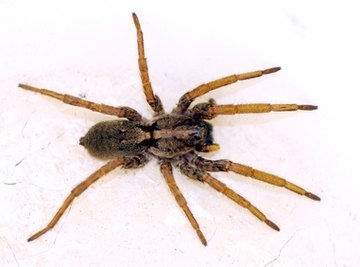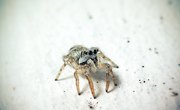
The world is home to over 45,000 recognized spider species, and many more likely exist that just aren't known to science yet! Of those numerous species, a wide variety of small brown spiders live and roam near human populations. You can find many types of house spiders and garden spiders in and around your home if you look in the right places.
Common House Spiders
As their name suggests, the common house spider isn't exactly a rare sight. You can usually find this species in dark spaces of sheds or buildings and within walls. This spider has light-colored markings and a brown or yellow-brown body. Its abdomen is large and round, and darker brown or gray. Its legs are lighter in color, often with slightly darker bands or markings.
Brown Recluse Spiders
This venomous species of spider typically measures less than an inch long. The easiest way to identify a brown recluse is by looking for the violin-shaped marking on its back near its head. However, many people misidentify this species, as there are several with similar markings. If you think you've encountered a brown recluse, your best bet is to check and see if their range extends into your area. If you think you might have been bitten by a brown recluse, take a photo of the spider if possible and seek immediate medical assistance.
Jumping Spiders
Jumping spider species come in a wide range of colors and patterns. Numerous brown-colored jumping spiders exist, so if you spot a tiny brown spider happily hopping about in pursuit of prey you might have encountered a jumping spider! They have very good eyesight, and will often turn to watch you as you walk past. Many species feature brightly colored patterns or spots and some even have iridescent or shiny coloration as well. If you look closely enough, you'll notice that these spiders have eyes arranged in three rows, which is the easiest way to identify them.
Wolf Spiders
Named for their impressive predatory behavior, these brown spiders actively chase down their small insect prey. Their bodies are brown with dark patterns, and the largest individuals reach a little over an inch long. Wolf spiders do not create webs. Instead, they pursue prey on foot and retreat to the safety of debris or a burrow when necessary. This spider is also well known for its top-notch parental care. Females carry their eggs on their back until they hatch, and continue to carry the newly-hatched young to protect them from predators.
Cellar Spiders
Cellar spiders are easily mistaken for daddy-longlegs. Like daddy-longlegs, cellar spiders have small bodies and long, thin legs. However, unlike daddy-longlegs, cellar spiders are true spiders! These arachnids live in dark spaces (such as cellars, of course). They spin haphazard webs lacking organization or pattern and tend to shake their webs when disturbed or threatened.
Funnel Web Spiders
Funnel web spiders are incredibly common in homes, sheds and other buildings. As you might have guessed, these spiders build funnel-shaped webs, typically coming out of crevices or cracks. The spider conceals itself deep within the crack or crevice and waits for insect prey to become entangled in the web near the entrance. When a likely meal gets stuck, the spider rapidly emerges and subdues its prey. This species looks similar to the brown recluse, but is harmless to people – but flies and small insects beware!
References
About the Author
Marina Somma is a freelance writer and animal trainer. She holds a B.A. in Psychology and a B.S. in Marine and Environmental Biology & Policy from Monmouth University. Marina has worked with a number of publications involving animal science, behavior and training, including animals.net, SmallDogsAcademy and more.
Photo Credits
brown spider image by João Freitas from Fotolia.com
